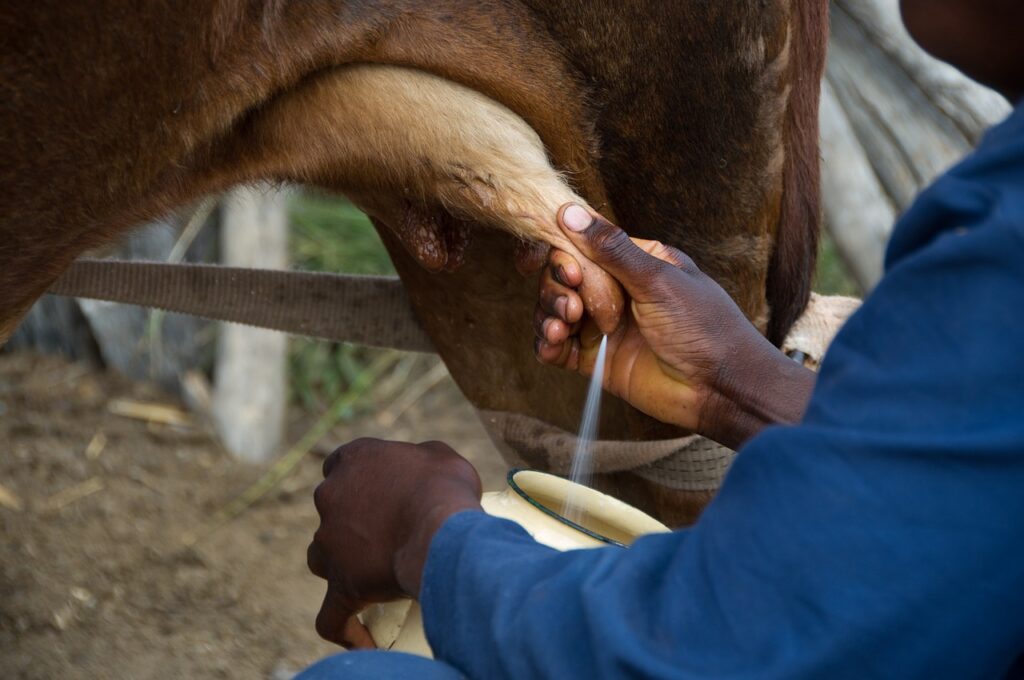Increasing milk production in dairy cows is essential for maximizing profitability and ensuring a sustainable dairy farming operation. Proper feeding strategies play a crucial role in achieving higher milk yields. This blog post will explore ten effective feeding strategies that can help boost milk production in cows.
Introduction
Milk production is the cornerstone of dairy farming, and achieving higher yields requires more than just good genetics. Nutrition and feeding practices are fundamental to enhancing milk production in dairy cows. By understanding and implementing effective feeding strategies, farmers can significantly improve the health and productivity of their herds. This guide will cover essential feeding practices, from providing a balanced diet to utilizing modern technology for monitoring and optimization.

10 Feeding Strategies to Boost Milk Production in Cows
1. Balanced Diet
A balanced diet is critical for maintaining cow health and maximizing milk production. Ensure the diet includes adequate amounts of carbohydrates, proteins, fats, vitamins, and minerals. Proper nutrition supports optimal body function and milk synthesis. Carbohydrates provide the necessary energy for milk production, proteins are vital for growth and repair, fats are a concentrated energy source, and vitamins and minerals support various bodily functions.
2. High-Quality Forage
Forage should be the foundation of your cows’ diet. High-quality forage, such as alfalfa, clover, and other legumes, provides essential nutrients and fiber. Good forage increases rumen efficiency and enhances milk production. To maintain high forage quality, focus on proper harvesting and storage techniques.
3. Concentrate Feeds
Concentrates, including grains like corn, barley, and oats, provide a concentrated source of energy. Balancing concentrate feed with forage is crucial to prevent digestive issues and optimize milk production. Concentrates are particularly important for high-producing cows that have higher energy demands. Overfeeding concentrates can lead to metabolic disorders such as acidosis, so finding the right balance is essential.

4. Nutritional Supplements
Incorporating nutritional supplements such as amino acids, vitamins, and minerals can address specific deficiencies in the diet. Common supplements include calcium, phosphorus, and magnesium, which support bone health and lactation. Selenium and vitamin E are important for immune function, while biotin can improve hoof health. Supplements should be used based on the specific needs of the herd.
5. Adequate Water Supply
Water is vital for milk production as cows need to stay hydrated. Ensure that cows have constant access to clean, fresh water. Water intake is directly correlated with milk yield, so monitor water sources regularly. A lactating cow can drink up to 100 liters of water a day, and any reduction in water intake can significantly affect milk production.
6. Feeding Schedule
Establishing a consistent feeding schedule helps maintain a stable rumen environment. Feed cows at regular intervals, ideally two to three times a day, to ensure continuous nutrient supply and reduce stress. A consistent feeding schedule also helps in managing feed intake and preventing overfeeding or underfeeding. Providing feed after milking can stimulate appetite and improve nutrient absorption.
7. Rumen Health
Maintaining rumen health is crucial for efficient digestion and nutrient absorption. Provide adequate fiber, avoid sudden dietary changes, and consider adding probiotics to enhance rumen function and overall health. The rumen is a complex ecosystem where microbes break down feed into nutrients that cows can absorb. Fiber is essential for rumen health as it stimulates chewing and saliva production, which helps in maintaining the rumen pH.
8. Silage Quality
Good quality silage can be an excellent feed source. Ensure proper fermentation and storage practices to maintain silage quality. High-quality silage improves feed efficiency and milk production. Silage should be stored in airtight conditions to prevent spoilage and preserve its nutritional value. Regularly inspect silage for mold and other contaminants.
9. Monitor Body Condition
Regularly monitor the body condition score (BCS) of your cows. Adjust feeding strategies based on BCS to ensure cows are neither underfed nor overfed. Proper body condition supports better reproductive performance and milk yield. A BCS system typically ranges from 1 to 5, with 1 being very thin and 5 being very fat. Monitoring BCS helps in identifying nutritional issues early and adjusting diets accordingly.
10. Use of Technology
Leverage technology such as precision feeding systems, automated feeders, and nutritional management software. These tools can help in monitoring feed intake, optimizing rations, and improving overall herd management. Technology can provide real-time data on feed consumption, cow health, and environmental conditions, enabling more informed decision-making. Precision feeding systems can deliver the exact amount of feed needed by each cow, reducing waste and ensuring optimal nutrition.

Conclusion
Implementing these feeding strategies can significantly impact milk production in dairy cows. A balanced diet, high-quality forage, consistent feeding schedules, and proper supplementation are key to achieving higher milk yields. Regular monitoring and use of technology can further enhance efficiency and productivity on your dairy farm.
To help farmers achieve these goals, ArtemisHealth offers advanced IoT devices for livestock health monitoring. Our solutions provide real-time data on feed intake, health metrics, and environmental conditions, enabling farmers to make informed decisions and optimize their dairy operations. Visit our website at artemishealth.io to learn more about how our technology can benefit your farm.
By adopting these practices and leveraging modern technology, dairy farmers can ensure the health and well-being of their cows while maximizing milk production.





